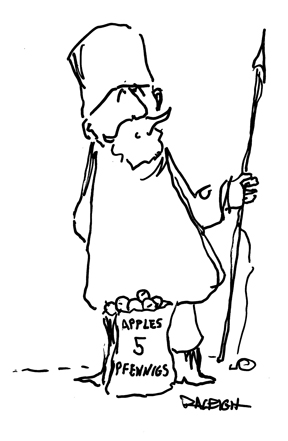Film:
The Three Required Great Works of Art
By Henry P. Raleigh
ART TIMES November/ December 2010
 |
I was taught very early in life that if you wished to be properly cultured and to hold your own among the literate of the world it was required to read Moby Dick. Having gotten through Silas Marner, the first Great Works of Art thrust upon you in those days, just wasn’t going to cut it. Moby Dick was the heavyweight introduction to Great Works of Art. After all, what could be more satisfying then to know you’ve read a book some 237 pages in length?
Now Moby Dick isn’t easy sledding, I can tell you, and it isn’t nearly as much fun as seeing the 1956 film adaptation and a lot shorter, too—it wasn’t around in my time, however. I don’t know if generations after mine have gotten away with simply picking up the DVD of “Moby Dick” and letting it go at that. They probably have considering that Catcher in the Rye seems to be the obligatory introduction to Great Works of Art in today’s high schools and that’s a snap compared to slogging your way through Melville’s novel.
Following a short pause while you mucked about making your way through the tiresome business of living you soon come to discover that tossing out clever quips about Captain Ahab and whale blubber is no longer sufficient in intelligent conversation. This brings you up against the second Great Work of Art that one can’t do without – Tolstoy’s War and Peace. And you’re not fooling anyone by knowing this massive work only via the woefully miscast American film version of 1956 or the incomprehensible Russian one in 1968. These films are no substitute for the mind-numbing task of actually reading the novel page-by-page—all 580 pages, anything less would be shameful, a stain upon your honor. (I do fear for those younger generations, though—if Catcher in the Rye is their basic training for Great Works of Art how will they be able to deal with War and Peace?)
After having a good portion of your existence given over to completing these two major cultural projects despite many false starts and distracted now and then by the temptations of the flesh you believe yourself content, wiser, well-rounded, and most likely wearing bi-focals. You feel deserving of a well-earned rest. Well sir, you’re wrong for the most difficult chore, the big number three of The Great Works of Art, the one that will separate the men from the boys, the women from the girls, yet awaits you. I mean here (I shudder to even write the words) Alfred Doblin’s acclaimed 1931 novel Berlin Alexanderplatz. I’ll bet they never told you about that one in school, did they? So before you bolt for the hills I’ll let you in on a dodge not available to those first two Great Works of Art. Rainer Werner Fassbinder’s epic 1980 film of the novel is really all you’ll need to claim your third cultural achievement. You might notice that in references to these works the novel is hyped merely as “acclaimed” while the film is always and resoundingly “epic”. It’s clear which is preferred. Why take second best and at any rate the novel is drenched in enough German romantic philosophy to give you a really bad headache.
The Fassbinder film is challenging, I should say, staggering, sixteen hour long and that’s plenty to give you boasting right if you can actually take it all in and don’t succumb to chronic depression. This is not a happy film as you will immediately tell because it’s photographed in shades of brown gloomily illuminated by strange lights, some like madly staring eyes, others that unnervingly pulsate. Although the setting is the late 1920’s amid Germany’s suffering in the Great Depression any viewer today will find it comfortably familiar what with political chicanery, casual sex, massive unemployment, and a general, pervasive discouragement with just about everything. You can see why the work is truly “epic”—like Great Art it shows us just how miserable we can get.
Once you have complete the required Three Great Works of art you may indeed hold your head high in any discussion with cultured people. With knowledgeable looks and a good deal of thoughtful nodding you can speak sagely of harpoons, funny Russian patronymics, and soup kitchens. Even those early films, “Moby Dick”and “War and Peace” will come in handy as back-ups—few read books nowadays but everyone talks about films, right?
